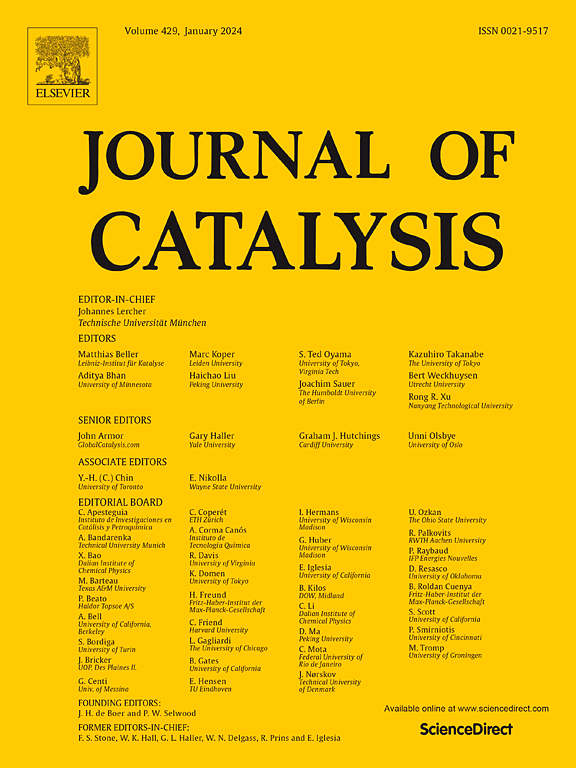优化 MOF 衍生 TiO2/C 催化剂对二氯甲烷的光催化降解:揭示碳纳米层的决定性作用和反应机理
IF 6.5
1区 化学
Q2 CHEMISTRY, PHYSICAL
引用次数: 0
摘要
深入剖析C-Cl键的活化和解离氯的迁移转化,对于理解光催化降解氯化挥发性有机化合物(CVOCs)过程中多氯副产物的形成和催化剂氯中毒失活的机理具有重要意义。本文通过对钛基mof的合理热解,构建了碳纳米层包裹TiO2复合材料(CTO)及其缺陷碳纳米层包裹TiO2 (DCTO)和不含碳纳米层的TiO2 (TO)对比催化剂。经3 h紫外-可见照射后,CTO对CH2Cl2的降解效率高达91.74 %,稳定性好,耐水性好,远远优于DCTO和to。密度泛函理论计算结合原位XPS发现,碳纳米层与TiO2之间的非均相界面相互作用极大地促进了光生成载体的分离,提高了CTO的氧化还原能力。同时,C-Cl键断裂产生的解离Cl可以优先吸附到外层碳纳米层上,从而抑制氯对TiO2活性位点的占据。解离Cl的优先吸附位点和优化的深度氧化能力协同提高了催化性能和抗氯中毒能力,抑制了多氯副产物的产生。本文章由计算机程序翻译,如有差异,请以英文原文为准。


Optimizing photocatalytic degradation of dichloromethane by MOF-derived TiO2/C catalyst: Unraveling the decisive role of carbon nanolayers and reaction mechanism
In-depth dissecting the activation of C-Cl bonds and the migration transformation of dissociated chlorine species is significant to understand the mechanism underlying the formation of polychlorinated by products and chlorine poisoning deactivation of catalyst during of the photocatalytic degradation of chlorinated volatile organic compounds (CVOCs). Herein, carbon nanolayers wrapped TiO2 composites (CTO), and its contrastive catalysts including defective carbon nanolayers wrapped TiO2 (DCTO) and TiO2 without carbon nanolayer (TO) are constructed by rational pyrolysis of titanium-based MOFs. The obtained CTO exhibits a remarkable degradation efficiency of up to 91.74 % for CH2Cl2 after 3 h of UV–vis irradiation, robust stability as well as water resistance, far superior to that of DCTO and TO. Density functional theory calculations combined with in-situ XPS reveal that the heterogeneous interface interactions between carbon nanolayers and TiO2 greatly facilitate the separation of photogenerated carriers, boosting the redox capacity of CTO. Simultaneously, the dissociated Cl species from the cleavage of the C-Cl bond can be preferentially adsorbed onto the outer carbon nanolayers, thereby inhibiting the occupation of TiO2 active sites by chlorine. The preferential adsorption sites of the dissociated Cl species and optimized deep oxidation ability synergistically boost the catalytic performance and resistance of chlorine poisoning and inhibit the production of polychlorinated by-products.
求助全文
通过发布文献求助,成功后即可免费获取论文全文。
去求助
来源期刊

Journal of Catalysis
工程技术-工程:化工
CiteScore
12.30
自引率
5.50%
发文量
447
审稿时长
31 days
期刊介绍:
The Journal of Catalysis publishes scholarly articles on both heterogeneous and homogeneous catalysis, covering a wide range of chemical transformations. These include various types of catalysis, such as those mediated by photons, plasmons, and electrons. The focus of the studies is to understand the relationship between catalytic function and the underlying chemical properties of surfaces and metal complexes.
The articles in the journal offer innovative concepts and explore the synthesis and kinetics of inorganic solids and homogeneous complexes. Furthermore, they discuss spectroscopic techniques for characterizing catalysts, investigate the interaction of probes and reacting species with catalysts, and employ theoretical methods.
The research presented in the journal should have direct relevance to the field of catalytic processes, addressing either fundamental aspects or applications of catalysis.
 求助内容:
求助内容: 应助结果提醒方式:
应助结果提醒方式:


